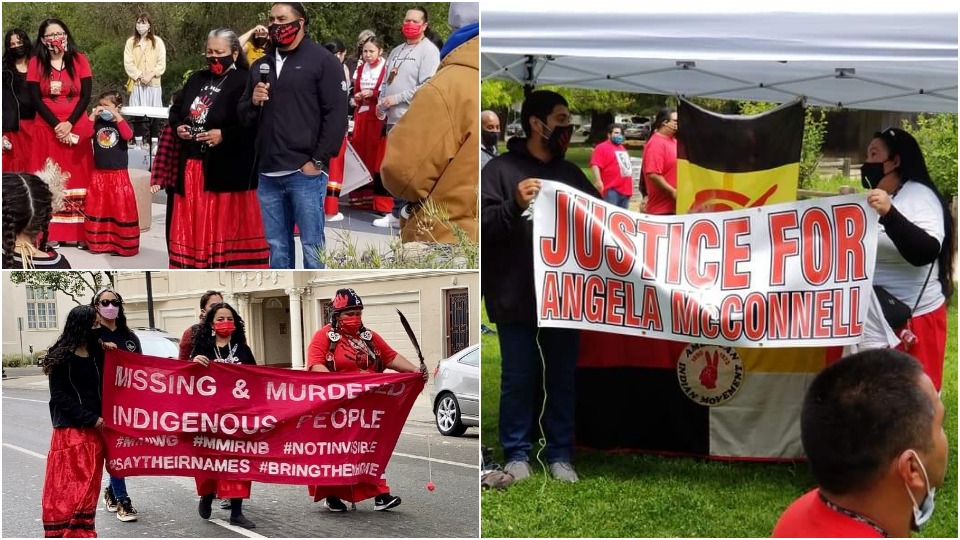
SACRAMENTO, Calif.—Hundreds of Native people and their allies marched through the streets of Sacramento to bring awareness to the epidemic of Missing and Murdered Indigenous Women (MMIW) that has plagued this country, and Northern California in particular, for years. It is hoped that this march will become an annual occurrence. Those who organized this first event hailed it as a “Prayer Walk.”
Several Indigenous organizations were behind the Apr. 25th event, including the Native Sisters Circle of Sacramento, the Sacramento Native American Health Center, the Native Dads Network, Restoring Justice for Indigenous Peoples, and the Wilton Rancheria Tribe.
The Native Sisters Circle of Sacramento said the march’s purpose was to bring about greater awareness of the horrendous tragedy that has beset Native women for decades in the United States. The Prayer Walk focused on several Indigenous women who’ve gone missing or been murdered in Northern California and law enforcement’s failure to investigate properly.
A recent report by the Sovereign Bodies Institute (SBI), a data-based nonprofit, Indigenous-led research organization based in Humboldt County, examines the failure to pursue the cases of 105 missing and murdered Indigenous women and girls throughout Northern California from the Bay Area to the Oregon border.
Utilizing police reports, federal and state data, community-focused information, and other research, the SBI uncovered more than 2,300 other cases in the U.S. There is no official, comprehensive database covering all MMIW cases. Undoubtedly, the real figure is much larger. Many Native victims are misclassified as other races, and some deaths are classified as accidental when, according to relatives, clear evidence of foul play is present.
Within Northern California, the SBI found that the most highly concentrated number of MMIW cases is in the “Lost Coast” region of Humboldt, Del Norte, and Mendocino Counties. The Bay Area makes up 16% of cases in the report that never made national headlines or gathered social media attention.
Northern California focus
The report made clear that the northern part of the state is a focal point for missing and murdered Indigenous people, which documented more than 70 cases in the past two decades. One in five occurred in Humboldt County.
Of these cases, 22% were Hoopa, 16% Yurok, and 11% were of the Round Valley Reservation.
Overall, there are more Indigenous people in California than any other state in the U.S. More than 700,000 reside here—on reservations, in rural areas, and in urban centers. There are 102 reservations in California, also more than in any other state. According to SBI, only a minuscule 9% of the murders of Indigenous California women have ever been solved, compared to 60% in the non-Native population, meaning that the killings of Indigenous women in the region are a shocking seven times less likely to be solved than those of any other demographic.
Thirty-one percent of the cases examined involved females 18 and younger, and nearly three-fourths of these cases had victims in the foster care system when they disappeared.
As for other cases where there is palpably a homicide, there is no indication of an adequate investigation in a majority of them—or any at all. This writer can speak personally to that issue, as in the case of our niece, Angela McConnell, Hoopa, related to my wife Melanie, who was brutally murdered in September 2018 in the City of Shasta Lake, Calif.
As of this writing, notwithstanding numerous and regular inquiries to the investigator assigned to the case, Detective Justin Brewer, the response is always the same: No information can be publicly released. As of lately, calls to Det. Brewer have not been returned. Most homicide investigators report that it is unlikely to get a break in a case months down the line; Angela’s case is now over two years old. Signs at the Sacramento march included “Justice for Angela McConnell.”
The continued loss of Indigenous women and girls, compounded by law enforcement laxity, it can be argued, stands as another form of the 500-year genocide of Indigenous people in this hemisphere. The narrative of the lives of Native women and girls cut short is replete with the routine minimal to a near-zero response by local law enforcement. Thousands of lives have been lost, thousands of lives of incalculable value—young women who had hopes and dreams for themselves and future generations of the Indigenous. This is indeed an epidemic that is stealing the countless lives of Native people from their families, their tribes, and their communities forever.
Haaland’s new investigative unit
Newly appointed Secretary of the Department of the Interior Deb Haaland, the first Native American (Laguna Pueblo) to hold that position in U.S. history, created a new government unit dedicated to the MMIW issue. Within the Bureau of Indian Affairs Office of Justice Services (BIA-OJS), Haaland ordered the establishment of a Missing and Murdered Unit to truly begin the pursuit of justice for Native women and Indigenous communities. The approach of the MMU is to provide leadership and resources to prioritize these cases and coordinate law enforcement resources throughout federal agencies and across Indian Country.
“Everyone deserves to be safe in their communities, but the missing Indigenous peoples crisis is one that the Native communities have faced since the dawn of colonization for too long,” said Haaland at the unit’s launch.
Haaland was undoubtedly alluding to the fact that the atrocities against Indigenous females go back centuries to Columbus and the colonization of the Americas, when his soldiers raped, sexually enslaved, and killed Native women and girls. He rewarded his lieutenants with sex slaves, particularly young girls forced into sexual slavery. In his letters, the infamous invader unabashedly wrote of his crimes:
“A hundred castellanos are easily obtained for a woman as for a farm, and there are plenty of dealers who go about looking for girls; those from nine to ten are now in demand, and for all ages a good price must be paid.”
This was clearly the sexual enslavement and molestation of children in its most debased, perverted, and sick form in the history of humanity. Many others were taken as captives back to Spain, where they were sex trafficked for the rest of their lives. The heinous atrocities committed against Native females have continued for hundreds of years and were a part of the genocide that wiped out the huge Indigenous populations of the Caribbean.
National Day of Awareness
In 2017, the Montana Congressional Delegation broke new ground with the passage of a Senate Resolution proclaiming May 5th each year as the National Day of Awareness for Missing and Murdered Native Women and Girls (MMIWG). The move came in response to strident demands for justice in the disappearance and murder of Hanna Harris on the Northern Cheyenne Reservation in 2013. May 5th is Hanna’s birthday.
On May 4, 2021, President Joe Biden officially proclaimed May 5th to be Missing and Murdered Indigenous Awareness Day to increase public attention to the matter and facilitate the efforts to bring justice to this ongoing crisis.
But since the first awareness day in 2017, the disappearances and murders of Native women have not abated. In further response, their grieving families and communities throughout Indian Country and Hawaii continue to call for justice and reforms to eliminate the systemic, racist obstacles that stand in the way of safety for Indigenous women. Indeed, there are calls for a National Week of Action for the MMIWG.
Indigenous women are currently victims of murder at rates more than ten times the national average. It is estimated that more than 5,000 American Indian and Alaskan Native women have gone missing or been murdered.
In Northern California, more Prayer Walks are being planned, with the next to be in Redding. The organizers feel that raising public consciousness at every opportunity is one of the best ways to deal with this ongoing crisis.
Read more:
Haaland: Crisis of missing and murdered Indigenous women demands solution
Another Indigenous murder still unsolved: Two years and counting for Angela McConnell










